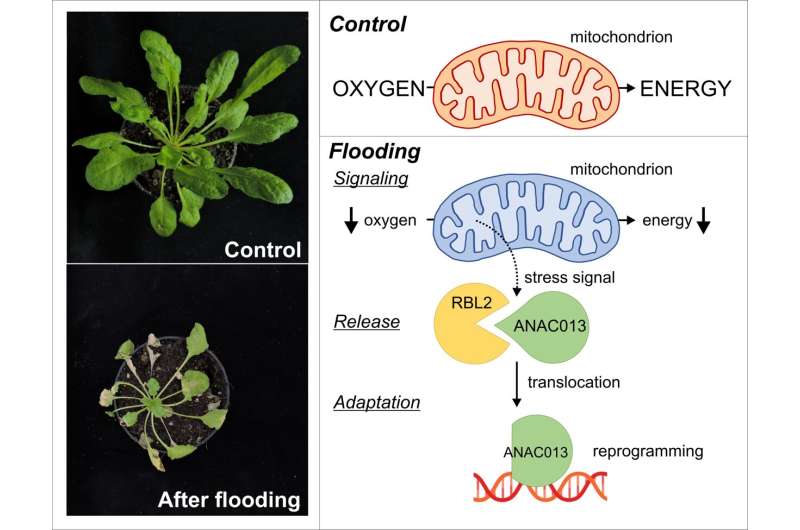This article has been reviewed according to Science X's editorial process and policies. Editors have highlighted the following attributes while ensuring the content's credibility:
fact-checked
peer-reviewed publication
proofread
Researchers discover a novel low oxygen signaling pathway in the model plant Arabidopsis thaliana

Climate change increases the occurrence of weather extremes. Most focus so far has been on prolonged drought and heat periods. However, the intensity of precipitation forms another threat, as excessive water causes waterlogging or in extreme cases flooding, resulting in low oxygen stress in plants.
A research team led by the IPK Leibniz Institute and the University of Bielefeld reports the discovery of a novel low oxygen signaling pathway in the model plant Arabidopsis thaliana. The molecular pathway links a mitochondrial stress signal during low oxygen to the initiation of a transcriptional adaptation response. The results have been published in the Proceedings of the National Academy of Sciences.
Aerobic reactions are essential to sustain plant growth and development. Impaired oxygen availability due to excessive water availability, e.g., during waterlogging or flooding, reduces plant productivity and survival. Consequently, plants monitor oxygen availability to adjust growth and metabolism accordingly.
Despite the identification of central components in hypoxia adaptation in recent years, molecular pathways involved in the very early activation of low-oxygen responses are insufficiently understood and prolonged periods of stress will have detrimental effects on plant yield and survival.
A cell harbors several organelles, including the endoplasmic reticulum (ER), which is a large dynamic tubular structure that surrounds the cellular nucleus and is involved in protein synthesis and lipid metabolism. The researchers characterized three ER-anchored Arabidopsis ANAC transcription factors, namely ANAC013, ANAC016, and ANAC017, which bind to the promoters of a subset of hypoxia core genes (HCGs) and activate their expression. Upon hypoxia, nuclear ANAC013 associates with the promoters of multiple HCGs.
It was found that a dormant transcription factor (ANAC013) bound to the ER membrane is released upon low-oxygen stress through proteolytic cleavage of its anchoring domain. Subsequently, the activated ANAC013 protein travels to the nucleus to initiate transcriptional reprogramming to induce adaptive responses.
"Not only did we identify the transcription factor responsible for this initial reprogramming, but also the protease, i.e, the enzyme capable of cutting proteins, that releases ANAC013 from the ER membrane," says Dr. Jozefus Schippers, head of IPK's research group Seed Development. The protease belongs to a class of so-called rhomboid proteases that are present in almost all species to regulate cellular processes.
However, substrates for these proteases were not reported in plants previously, indicating the novelty of the uncovered mechanism in our work.
In addition, the researchers were able to demonstrate that cleavage of ANAC013 by the rhomboid protease relies on a mitochondrial-derived signal.
"We expect that exploring the molecular nature of the upstream signal will be of extreme interest for understanding organellar communication. Moreover, as the newly identified module consisting of the ANAC013 factor and its processing protease is highly conserved in plants, we envisage that the obtained results can be translated to crops to improve their waterlogging tolerance," says Prof. Dr. Romy Schmidt-Schippers from the University of Bielefeld.
More information: Emese Eysholdt-Derzsó et al, Endoplasmic reticulum–bound ANAC013 factor is cleaved by RHOMBOID-LIKE 2 during the initial response to hypoxia in Arabidopsis thaliana, Proceedings of the National Academy of Sciences (2023). DOI: 10.1073/pnas.2221308120
Journal information: Proceedings of the National Academy of Sciences
Provided by Leibniz Institute of Plant Genetics and Crop Plant Research



















